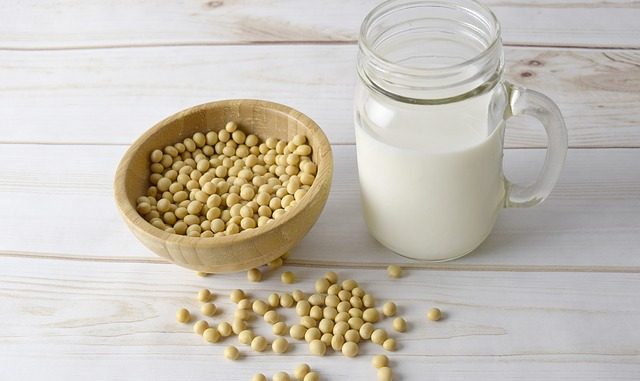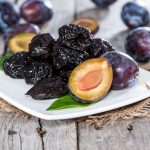
Soy or soya milk is a highly nutritious drink much loved by a wide community. The drink is naturally high in various proteins, fiber, various vitamins and minerals and essential fatty acids. It is preferred to nut milks by some adopting a vegetarian or vegan diet. Extra benefit is obtained by fortifying the milk with calcium and vitamin D.
It does have an allergy warning associated with it.
Manufacture
Soy milk is a product made from whole soybeans or full-fat soy flour. The beans are dried then soaked in water overnight for a minimum of four hours depending on the process water temperature. Having rehydrated the beans, these are ground to produce a final product giving a defined solids content with a protein content of between 1 and 4 percent. Water is often added during the wet milling process to achieve the desired specification. Traditional soy milks have a water to bean weight ratio of 5:1. A soy beverage is much more dilute, four times more so with a water to bean weight ratio of 20:1.
The slurry is boiled to improve flavour by inactivating enzymes which cause browning and taste loss. An anti-foaming agent needs to be added before boiling as soy milk readily foams. Sometimes the soy milk is filtered before hand to reduce a certain degree of foaming. A key enzyme affected destroyed is soybean trypsin inhibitor which helps with flavour retention and development. Heating also serves to pasteurise the product and stabilise it for longer shelf-life. The heating period lasts between 15-20 minutes with a boil of about 5 to 10 minutes. Insoluble residues called soy pulp fibre are filtered or decanted away.
The milk appears white, opaque and similar in consistency to cow or buffalo milk.
Reduces Risk Of Prostate Cancer And Prostate Hypertrophy
Soy milk is notable for being a rich source of isoflavones which are known as phytoestrogens that mimic the sex hormone estrogen. Phytoestrogens have similar molecular structures to estrogen which is the basis for their activity. According to the web-site for SoyLife® phytoestrogens selectively activate or block receptors that bind estrogen. This property is described as a Selective Estrogen Receptor Modulator (SERM). Such pro- or anti-estrogenic effects help modulate and balance the various biochemical mechanisms that depend on estrogen.
One phytoestrogen acts as an inhibitor of testosterone production in men and there is gathering research that a particular peptide called lunasin is also implicated. Research shows that reducing testosterone levels helps to significantly reduce the risk of development of prostate cancer. Consuming a soya-rich diet is claimed to reduce risks of developing both conditions.
Reduces Risk Of Osteoporosis
Osteoporosis is a debilitating disease especially for women in the post-menopausal phase of their life. The condition develops as a result of acute hormonal changes, a consequence being removal of calcium from the skeleton. That process can lead to severe bone weakening with fractures and formation of bends and curvature as in a Dowager’s Hump. The phytoestrogens in soy milk can promote calcium reabsorption into the body’s skeletal bone and so lessen the overall loss of bone mass.
Fortified soya milk with calcium and vitamin D is highly beneficial here.
Reducing The Impact Of Post-Menopausal Issues
As well as osteoporosis, other conditions arise in women because of the reduced production of the key sex hormone, oestrogen (estrogen). Low levels of estrogen lead to increased risks of diabetes, obesity and cardiovascular (heart) disease in post-menopausal women. Various psychological issues are also experienced including hot flushes, mood swings, depression and sleeping problems like sleep apnoea and insomnia.
Promoting Better Skin
Skin aging is affected by a number of external and internal factors. Changing estrogen production during and after menopause means general skin tone declines. The skin sags and becomes wrinkled. It also stiffens and loses elasticity. The process responsible for thee marked aging effects is collagen protein glycation. It occurs when glucose cross-links collagen molecules which makes the skin structure more rigid and inflexible. Isoflavones in soya and milk act like HRT (hormone replacement therapy) by preserving collagen content, retaining elasticity in the skin and preserving skin’s thickness. Isoflavones appear to have benefits as a ‘beauty from-within’ component.
Improving Your Blood Lipid Levels
One of the strongest benefits of soy milk is modifying and improving the blood lipid profile. It is a good product to take for those of us with hypercholesterolemia (high blood cholesterol levels) or have a family history of coronary heart disease. Soy milk contains mostly unsaturated fatty acids with no cholesterol. It compares highly favourably with any dairy milk because it is high in saturated fats and cholesterol.
Research shows that a mix of monounsaturated (MUFAs) fats and polyunsaturated fats (PUFAs) helps inhibit cholesterol movement and transport throughout the blood system. Clinical research shows that a regular intake of soy generally raises the levels of high density lipoproteins (HDLs) and lowers blood concentrations of low density lipoproteins (LDLs) and triglycerides.
Helping With Weight Loss
Soy milk has a lower sugar content and calorific content per unit weight than dairy milks, and cow’s milk in particular. Soy milk has a calorific value of 80 calories which is similar to skimmed milk as it contains 7 grams of sugar per cup. Cow’s milk has about 12 grams of sugar per cup. There is a significant amount of fibre in soy milk which also helps with weight loss because it increases viscosity in the gut and creates feelings of satiety and fullness in the stomach. Monounsaturated fatty acids in soy milk also help inhibit the intestinal absorption of fat which is also helpful in reducing weight loss.
Issues With Soy Milk For Babies
Soy milk formula is generally not recommended for weaning babies owing to various issues of high manganese levels. It is a common enough occurrence in Asian countries where substitutes for dairy are sought. A soy milk formula for babies in the first six months after birth places them at a small risk from excess manganese consumption. The reason is that the liver has not developed the functions for dealing with excess heavy metals like manganese at this point.
For adults manganese is a valuable element found in birch sap for example. The manganese content in soy formula is somewhere between 50 and 80 times more than breast milk and commercial baby milks. Too high a manganese content can to particular behavioural disorders and learning disabilities. One consequence is attention deficit disorders like ADD or ADHD.
Please note this page contains links to our affiliate marketing partner. Please read our affiliate disclosure.

Leave a Reply